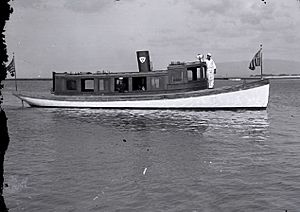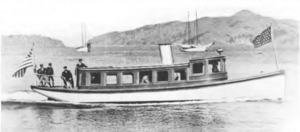USRC Waterwitch facts for kids
The USRC Waterwitch was a special motorboat used by the United States Customs Service and Revenue Cutter Service in Hawaii. For 28 years, from 1903 to 1931, it served as their official boat for boarding ships.
The Waterwitch was built in 1900 by Peter Swanson in Belvedere, California. It was made for Archie Young, who worked for the Von Hamm-Young company. The boat was 50 feet long and weighed 13 tons. It had a 40-horsepower Union gas engine and electric lights. The Waterwitch could carry 25 to 50 people, including passengers and crew.
In 1903, the Waterwitch was brought to Oʻahu, Hawaii, on a schooner called the Rosamond. It arrived on October 3, 1900.
First Voyage and the Young Brothers
The Waterwitch took its first trip on October 6, 1900. Commodore Archie Young was in charge. The crew included William and Herb Young, who were brothers but not related to Archie. On this trip, the Waterwitch sailed around Honolulu Harbor and the southeast coast of the island. It then went to Pearl Harbor and back, reaching speeds of up to 12 knots.
William and Herb Young arrived in Hawaii in January 1900. They had to stay in quarantine for three months because of a health outbreak in Honolulu. While waiting, they worked as crew members, moving supplies between the islands. They did many small jobs, like fixing boats and salvaging items.
Once they could enter Honolulu, they started working for Archie Young in April 1900. They also continued their own small businesses. They towed garbage, delivered supplies to ships, and offered pleasure trips around the harbor. By August 1900, they got a license to carry passengers. They used a small boat called the Billy to ferry sailors back to their ships.
All these small jobs led to the Young Brothers company, which they started in 1900. Their business did well, and two more of their brothers came from San Diego to join them. In 1902, the Young brothers bought the Waterwitch. They soon won a contract to rent it out as the official Customs and Immigration boarding boat for the island. They fixed up the boat for this new job, even removing six sleeping berths.
In 1900, Honolulu had about 45,000 people. Its harbor was only big enough for small boats. Large ships had to anchor offshore. Passengers and goods were then moved to shore using smaller launches and boats.
Working for Customs
The Waterwitch started its contract with the Customs Service in May 1903. It became a revenue and patrol boat, taking officers out to ships that were arriving. It first flew the revenue flag on May 25, with Captain Herb Young steering the boat. The Waterwitch worked this job for 28 years. It often met 8 to 10 ships every day.
The crew of the Waterwitch wore special coats. These coats had two rows of buttons, one for the Customs Service and one for the Immigration Department.
Over the years, the boat's engine was upgraded several times. It went from 40 horsepower to 50, and then to 100 horsepower. One evening in the 1930s, a crew member was cleaning the boat. He lit a match to see if it was dry, and fumes caused an explosion. The boat's whistle was blown onto the shore. Luckily, the crew member survived, but his arms were badly burned.
In its last ten years of service, the Waterwitch also worked as a pilot boat. Sometimes, it would take people out to greet incoming large passenger ships.
The Waterwitch was often the first thing visitors saw when they arrived in Hawaii by sea. One visitor was Brother Bertram Bellinghausen, who took many photos of the boat in 1905. His large collection of photos is now in the Hawaii Museum. By 1937, the Waterwitch looked very different. It had new features and a new engine, making it twice as fast as before.



